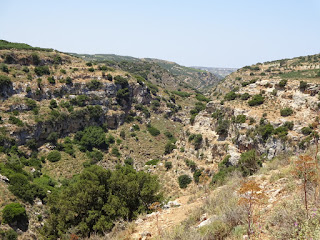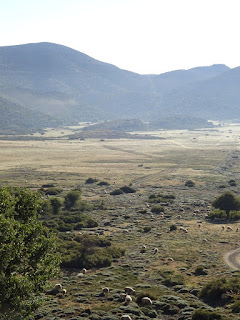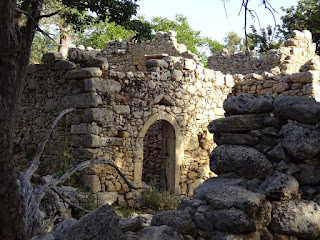The E4 in Greece, marked intermittently with yellow and black diamonds or stripes, crosses some diverse landscapes. In the north things are greener, with more trees on the mountains, pines higher up and beech and other deciduous species lower down. In the south things get dryer and dustier, with more prickly Holm oak (after visiting the Natural History museum in Heraklion I now realise I should have distinguished Holm Oak from Kermes Oak both having spiky, holly like leaves and both common in the region). Crete seemed particularly dry and rocky. There also seemed to be more stiff thorny vegetation in the drier, southerly areas, but fewer brambles. In most of mainland Greece it was common to encounter shepherds or goatherds walking with their flocks as they grazed, accompanied by some aggressively barking dogs that required some caution when approaching. In Crete this was not common, as a lot of the land now seems to have been fenced (the Psiloritis mountains being an exception).
Many more people walk the Crete and Peloponnese sections of the E4 than do the more northern sections where I met no other E4 hikers. A shame as I enjoyed my walk through Macedonia, Thessaly and the Pindus mountains every bit as much. Mount Olympus is an exception with large numbers of people following the E4 route from Litochoro to the summit, none seem to continue down the other side.
A noticeable feature of walking the E4 in Greece is the number of small churches you pass, which seem to increase in number the further south you go. These appear in high places, mountain passes and the like. Some are rather beautiful inside with their wall paintings, icons and golden lamps. Some are old going back to the 14th century, some are very recent, although you would probably not realise unless you saw a year from the 1980s or similar displayed in the stonework. There are also small shrines by the roadside, some clearly mass produced but individually cared for. Monasteries are also encountered throughout Greece.
Little cafes, which in mainland Greece were usually found in the square by the church under a plane tree, were excellent places to take a break with a Greek coffee, a Coke or Lemonade. I had a number of coffees or similar generously bought for me in Greece by friendly locals, especially in places less visited by walkers. Maybe I was a bit of a novelty or maybe they were proud that someone from England had visited their little village. There was also suspicion in the north though, with people asking what I was doing, and not just out of curiosity.
The Greek bakeries were a pleasurable place to pick up a snack and there was a lot more variety to Greek food than just mousaka. It helped to take whatever it was they had on the go, although where they spoke no English "Souvlaki", "salata" and "eliniko cafe" generally worked. It also helped to say "fagito?" pronounced "fayito?", which means "food?", as it was sometimes difficult to tell if food was available. I was surprised that I was often offered vegetarian food, something that was rare when I first visited Greece many years ago.
To navigate the E4 through Greece I used a GPS preloaded with tracks downloaded from the internet or created by myself, and a map on the SD card. The main sources of downloaded tracks were waymarkedtrails.org and traildino.com, I also used e4-peloponnes.info in the Peloponnese and in Crete tracks supplied by the people behind the Cretan Way guidebook. Where I could not find a GPS track for a section I created it from maps published by Anavasi, the main producer of maps suitable for hikers in Greece, or else I constructed one from tracks published on wikiloc.com and using Google Earth. (Update: I have recently discovered Geopsis also produce hiking maps of Greece, check out their site as well as Anavasi's). To help others, in those areas where GPS tracks for the E4 are not available or are incomplete I have loaded my own tracks, based on where I actually walked, onto wikiloc.com and viewranger.com (on MyViewRanger search routes for "johnpon"). I used GPS maps from Navitracks.de, their Balkans map and later their Greek map, which seemed quite similar. By no means complete, and with contouring that was not very detailed they were the best available. I had some digital maps from Anavasi but found these more useful in my preplanning for creating my GPS tracks, than when actually walking the route, as they were not "vectorised" maps and slow to load.
You could get away with using a decent smart phone instead of a dedicated GPS but charging it could be an issue in remote areas. I did find the default Viewranger maps useful on occasion when I needed to divert from my planned route as my phone gave a larger screen than my GPS, and was quicker to zoom and pan. Diversions from the official E4 or my planned routes where needed on a number of occasions whether due to paths being too overgrown or excessive snow.
Although Greece is reasonably well blessed with small hotels, guesthouses and rooms on the E4, there were still days in the mountains when I needed to wild camp. This was not generally a problem except in Crete where its rocky landscape and thorny vegetation did not make good pitches (although you can hide on flatter ground in someone's olive grove).
Including travel from the UK and rest days I spent a total of 90 days crossing Greece on the E4, around 3 months in two separate visits. It may be difficult to do it in one go as either you will encounter excessive heat in the summer or excessive snow on the mountains in winter. Having allocated the time it is not a difficult thing to do and you will be rewarded by many things expected and unexpected....
Links to different parts of my trip:
Start of walk on E4 through Greece
General comments on Macedonian section of E4
General comments on E4 between Florina and Litochoro
General comments on E4 between Mt Olympus and Kalambaka
General comments on E4 in Pindus mountains
General comments on E4 in Peloponnese
General comments on E4 in Crete
The walk through Greece is part of a longer project to walk the E4 from its start in Tarifa in Spain to its end in Cyprus. I have written blogs on various sections. Links are below:
Blog on E4 walk in Hungary from Budapest (prior to Budapest John Hayes provides an inspirational account)
Blog of walking across Serbia on the E4
Blog of crossing Bulgaria on the E4
Blog of crossing Cyprus on the E4
Although not officially part of the E4 you can start the walk from the tip of Portugal, the section from Cape Vincent to Tarifa is blogged here.
Many more people walk the Crete and Peloponnese sections of the E4 than do the more northern sections where I met no other E4 hikers. A shame as I enjoyed my walk through Macedonia, Thessaly and the Pindus mountains every bit as much. Mount Olympus is an exception with large numbers of people following the E4 route from Litochoro to the summit, none seem to continue down the other side.
A noticeable feature of walking the E4 in Greece is the number of small churches you pass, which seem to increase in number the further south you go. These appear in high places, mountain passes and the like. Some are rather beautiful inside with their wall paintings, icons and golden lamps. Some are old going back to the 14th century, some are very recent, although you would probably not realise unless you saw a year from the 1980s or similar displayed in the stonework. There are also small shrines by the roadside, some clearly mass produced but individually cared for. Monasteries are also encountered throughout Greece.
Little cafes, which in mainland Greece were usually found in the square by the church under a plane tree, were excellent places to take a break with a Greek coffee, a Coke or Lemonade. I had a number of coffees or similar generously bought for me in Greece by friendly locals, especially in places less visited by walkers. Maybe I was a bit of a novelty or maybe they were proud that someone from England had visited their little village. There was also suspicion in the north though, with people asking what I was doing, and not just out of curiosity.
The Greek bakeries were a pleasurable place to pick up a snack and there was a lot more variety to Greek food than just mousaka. It helped to take whatever it was they had on the go, although where they spoke no English "Souvlaki", "salata" and "eliniko cafe" generally worked. It also helped to say "fagito?" pronounced "fayito?", which means "food?", as it was sometimes difficult to tell if food was available. I was surprised that I was often offered vegetarian food, something that was rare when I first visited Greece many years ago.
To navigate the E4 through Greece I used a GPS preloaded with tracks downloaded from the internet or created by myself, and a map on the SD card. The main sources of downloaded tracks were waymarkedtrails.org and traildino.com, I also used e4-peloponnes.info in the Peloponnese and in Crete tracks supplied by the people behind the Cretan Way guidebook. Where I could not find a GPS track for a section I created it from maps published by Anavasi, the main producer of maps suitable for hikers in Greece, or else I constructed one from tracks published on wikiloc.com and using Google Earth. (Update: I have recently discovered Geopsis also produce hiking maps of Greece, check out their site as well as Anavasi's). To help others, in those areas where GPS tracks for the E4 are not available or are incomplete I have loaded my own tracks, based on where I actually walked, onto wikiloc.com and viewranger.com (on MyViewRanger search routes for "johnpon"). I used GPS maps from Navitracks.de, their Balkans map and later their Greek map, which seemed quite similar. By no means complete, and with contouring that was not very detailed they were the best available. I had some digital maps from Anavasi but found these more useful in my preplanning for creating my GPS tracks, than when actually walking the route, as they were not "vectorised" maps and slow to load.
You could get away with using a decent smart phone instead of a dedicated GPS but charging it could be an issue in remote areas. I did find the default Viewranger maps useful on occasion when I needed to divert from my planned route as my phone gave a larger screen than my GPS, and was quicker to zoom and pan. Diversions from the official E4 or my planned routes where needed on a number of occasions whether due to paths being too overgrown or excessive snow.
Although Greece is reasonably well blessed with small hotels, guesthouses and rooms on the E4, there were still days in the mountains when I needed to wild camp. This was not generally a problem except in Crete where its rocky landscape and thorny vegetation did not make good pitches (although you can hide on flatter ground in someone's olive grove).
Including travel from the UK and rest days I spent a total of 90 days crossing Greece on the E4, around 3 months in two separate visits. It may be difficult to do it in one go as either you will encounter excessive heat in the summer or excessive snow on the mountains in winter. Having allocated the time it is not a difficult thing to do and you will be rewarded by many things expected and unexpected....
Links to different parts of my trip:
Start of walk on E4 through Greece
General comments on Macedonian section of E4
General comments on E4 between Florina and Litochoro
General comments on E4 between Mt Olympus and Kalambaka
General comments on E4 in Pindus mountains
General comments on E4 in Peloponnese
General comments on E4 in Crete
The walk through Greece is part of a longer project to walk the E4 from its start in Tarifa in Spain to its end in Cyprus. I have written blogs on various sections. Links are below:
Blog on E4 walk in Hungary from Budapest (prior to Budapest John Hayes provides an inspirational account)
Blog of walking across Serbia on the E4
Blog of crossing Bulgaria on the E4
Blog of crossing Cyprus on the E4
Although not officially part of the E4 you can start the walk from the tip of Portugal, the section from Cape Vincent to Tarifa is blogged here.
Update: Based on my travels on the E4 I have written a book "Six Pairs of Boots: Spain to Cyprus on the E4 Trail" by John Pucknell available from Amazon.co.uk, Amazon.com, the Bookdepository.com, lehmanns.de, bookspot.nl, and other good online bookstores.










































